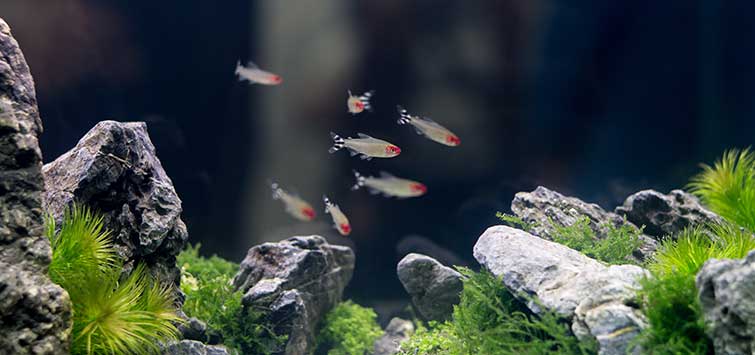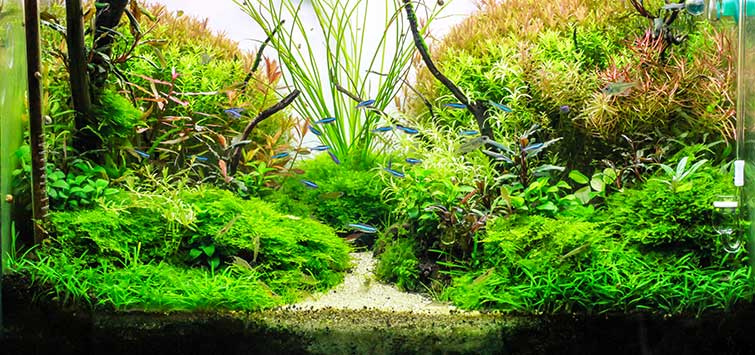A Long-Term Layout for the Nature Aquarium
Author: Takashi Amano
The master of the planted aquascape discusses ways to keep the Nature Aquarium healthy and beautiful over time.
I have discussed basic layout methods for the Nature Aquarium in past articles; this month I would like to go a step further and introduce a layout method with consideration for long-term maintenance.
Understanding Aquatic Plants
In the Nature Aquarium, a layout consists of the foreground, the middle ground, and the background, and aquatic plants are selected so that the height of the plants becomes progressively taller from the foreground to the background, as a general rule. Even if they are very small when planted initially, however, most plants eventually become larger through their natural growth processes. Therefore, some repeated care becomes necessary, such as trimming them back or cutting off large leaves, depending on the type of plants.
If a layout is to be maintained for a long time, such as three or even five years, it becomes important to consider some method for providing care efficiently and maintaining the layout in a beautiful condition over time. Some plants—stem plants, for example—grow quickly and require frequent trimming, and they tend to decline when maintained in this fashion for a while. On the other hand, plants like ferns grow very slowly and take a long time to become dense, but they can be enjoyed for a long time.
It is important to understand the biological characteristics of various aquatic plants, and realize how these characteristics differ from plant to plant, in order to use the plants in an appropriate arrangement that may be maintained in a layout for a long period of time.
The Challenge of Long-Term Maintenance
Consider the reasons why it becomes difficult to maintain a layout as originally designed over a long period of time. Aside from algae outbreaks caused by poor aquarium conditions or degraded water quality, the biggest reason that an aquatic plant layout becomes difficult to maintain is, ironically, the excessive growth of aquatic plants.
For example, Glossostigma, which is often used in the foreground, grows on top of itself and forms thick layers of runners and leaves if left growing unchecked. Light does not reach those underneath layers and water does not flow through them, and so the lower parts of the plants eventually start dying. The same thing can be said about the stem plants in the background. When this happens, the layout will collapse.
That does not mean that the layout with light-loving plants cannot be maintained for a long time, but it is a fact that such a layout requires frequent trimming. When Glossostigma and stem plants are trimmed, it takes about two weeks for them to grow back to a beautiful condition. Since most of us want to enjoy a layout in a beautiful condition for a long time if possible, the way we build the middle ground becomes a key point for this purpose.
Middle Ground Maintenance Is Crucial
The middle ground ties the foreground and the background together. Layout materials such as rocks and driftwood are arranged there, as are select aquatic plants. It is a very important area for rendering a natural feel to the Nature Aquarium.
Aquatic plants used in the middle ground are limited to those that do not grow tall; therefore, stem plants are rarely used. The plants in the genera Cryptocoryne and Echinodorus, as well as other rosette plants, are often used there. Ferns and the plants in Anubias family that are grown attached to layout materials such as rocks and driftwood are also often used for the middle ground.
Cryptocoryne, Echinodorus, and other rosette plants are limited only to the medium-sized types. Among Cryptocoryne, brown and green C. wendtii, C. petchii, C. beckettii, C. walkeri, C. undulata, and C. cordata are often used, depending on the size of an aquarium. Among Echinodorus, E. tenellus, E. latifolius, and E. grisebachii are suitable. There arevarious Cryptocoryne, Echinodorus, and other rosette plants that have long tape-shaped leaves that will stretch to the water surface, but these large-leaves plants are not suitable.
Aside from the plants mentioned above, hair grass, Blyxa short leaf, and pygmy chain Sagittaria are also suitable for the middle ground. Some of the advantages of these rosette-type plants are that they grow slower than stem plants and that they can be maintained relatively easily by removing large old leaves and cutting off outstretching runners. Since ferns and Anubias (the small to medium-sized type) grown attached to rocks and driftwood are shade-loving plants, they grow relatively slowly and require little work to maintain. Therefore, these plants are indispensable for the Nature Aquarium intended for long-term maintenance.
If the plants in the middle ground are growing densely, a layout is worth viewing even right after the stem plants in the background are trimmed. If the middle ground is built well using layout materials and the proper aquatic plants, a layout can be maintained for a long time without losing the overall balance, even with repeated trimming of the background plants.
Foreground Maintenance
If plants such as Glossostigma are used in the foreground, it is possible to maintain them by trimming early and frequently. If you would rather spend less time and effort to maintain the layout over a long period of time, however, you can use cosmetic sand with no plants in the foreground. A light-colored, natural-looking cosmetic sand is well suited for this type of foreground application.




